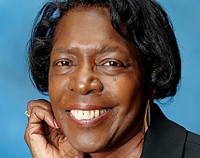Advertisement
Grab your lab coat. Let's get started
Welcome!
Welcome!
Create an account below to get 6 C&EN articles per month, receive newsletters and more - all free.
It seems this is your first time logging in online. Please enter the following information to continue.
As an ACS member you automatically get access to this site. All we need is few more details to create your reading experience.
Not you? Sign in with a different account.
Not you? Sign in with a different account.
ERROR 1
ERROR 1
ERROR 2
ERROR 2
ERROR 2
ERROR 2
ERROR 2
Password and Confirm password must match.
If you have an ACS member number, please enter it here so we can link this account to your membership. (optional)
ERROR 2
ACS values your privacy. By submitting your information, you are gaining access to C&EN and subscribing to our weekly newsletter. We use the information you provide to make your reading experience better, and we will never sell your data to third party members.
Careers
Help Diversify ACS National Awards
by George M. Bodner, Chair, And Valerie J. Kuck, Past-Chair, ACS Board Committee On Grants & Awards
February 22, 2016
| A version of this story appeared in
Volume 94, Issue 8
The four goals in the ACS strategic plan not only can but will change with time. What will not change is the set of core values upon which the plan is constructed. One of these core values is diversity and inclusion. The focus on achieving diversity and inclusion is not something relegated to a committee, office, or ACS program. It is something that has been integrated into every facet of the society’s activities. Because of our long-term commitment to achieving diversity in the grants and awards program, it is painful to admit that recent criticism of the diversity of ACS national awards recipients is valid. Obviously, more work has to be done.
The mission of the ACS Board Committee on Grants & Awards (G&A) is to support and encourage the pursuit of excellence in the chemical sciences by honoring outstanding contributions to the chemical enterprise through the ACS fellows and ACS national awards programs. This comment will focus on our achievements in meeting the goals of diversity and inclusion in these programs for two underrepresented groups—women and industrial chemists.
The ACS Fellows Program for 2015 achieved a remarkable level of diversity in terms of gender, with percentages of male and female recipients that closely mirror the overall ACS membership. The program, however, was far from attaining the goals of inclusion when the percentage of new fellows from industry (21%) is compared with industrial members’ fraction of the total ACS membership (52%).
As some have noted, the national awards program has been characterized by a significant underrepresentation of both women and industrial chemists in recent years. In theory, this could be because of a problem of bias within the award selection process. Or it could result from unevenness in the number of individuals from different groups who are nominated for the national awards.
To probe whether the observed underrepresentation of women and industrial chemists was the result of bias within the selection process or the lack of nominations from a particular group, we analyzed the nominees and the recipients for the national awards for the years 2012 to 2016. We concluded that the problem of underrepresentation among recipients of the national awards was not the result of bias among members of the award selection committees. During those five years, women, on average, comprised 13% of the nominees but 16% of the national award recipients. It should also be noted that the percentage of national awards received by industrial chemists (14%) in 2016 was much larger than the percentage of nominations (6%) from this group.
The data clearly indicate that the underrepresentation of women and industrial chemists among recipients of ACS national awards can be linked to their underrepresentation in the pool of nominations for these awards. The percentage of women among nominations for national awards is roughly half of their percentage of ACS membership. Further evidence that the lack of nominations is a major source of the problem can be found by noting that there were no nominations of women for as many as 16 of the national awards for the 2014 through 2016 award cycles.
G&A has been working for years to improve the diversity and inclusion of underrepresented groups among nominees for national awards. Since 2009, G&A has collaborated with the Association for Women in Science on a National Science Foundation-funded project titled Advancing Ways of Awarding Recognition in Disciplinary Sciences (AWARDS) that has a target of gender equity in the awards process in STEM (science, technology, engineering, and mathematics) disciplines. Several years ago, G&A created an Awards Equity Implementation Team, which developed a set of best practices that is provided to all members of the national award selection committee to ensure that all nominees are evaluated fairly.
To achieve our goals of diversity and inclusion, the representation of women and chemists from industry on national award selection and canvasing committees has been dramatically increased. We have also created new canvasing committees for awards having few or no female nominees. Each July, letters are sent to ACS technical division officers with a list of national awards closely tied to their division requesting help in nominating individuals from underrepresented groups. In addition, letters have been sent to department chairs of chemistry departments at R1 research universities requesting their assistance in increasing the number of women nominated for national awards.
More recently, the underrepresentation of industrial chemists was discussed during the inaugural Chemical Sciences Chief Technology Officer (CTO) Summit organized by ACS Executive Director and Chief Executive Officer Thomas Connelly and 2015 ACS President Diane Grob Schmidt.
G&A will continue to seek ways to ensure that our programs meet the tests of best practices for diversity and inclusion. What we need now is help from ACS members. Please send suggestions for possible improvements in the awards program to LaTrease Garrison (l_garrison@acs.org), staff liaison to G&A, or to one of the authors of this comment. And please work with your division or local section to nominate worthy candidates.
Your efforts as members of the society are critical to achieving diversity and inclusion in our national awards program.
Views expressed on this page are those of the author and not necessarily those of ACS.






Join the conversation
Contact the reporter
Submit a Letter to the Editor for publication
Engage with us on Twitter